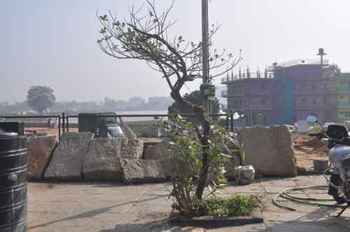This centuries-old, elegant but small, temple in Begur is a place where Lord Shiva is worshipped. Begur temple is about 3.6 kms down Begur Road from the Bommanahalli junction on Hosur Road. People visit the temple to perform pujas or just a weekly ritual. I visited the place as part of a heritage walk organised by INTACH, Bangalore and the Bangalore City Project, on a bright Sunday morning, last month.
Begur Temple

Begur Temple from the side. Pic: Meera K.
The domes of the twin temple are built in typical Dravidian style. The floor is raised slightly higher than the ground and the roof is low. The pillars inside are sculpted in different styles essaying the fact that the temple must have been expanded in different periods of history. There are five lingas in the temple, each dedicated to a different form of Ishvara (Shiva). Among them, the temple of Nageshvara is the oldest and dates back to 900 AD. One can plainly see that it’s difficult for a six footer to stand in the temple without bending a little. Maybe that was the intention; that even the mighty should bow to the lord.
The temple has many inscriptions that date back to this period. In fact, the oldest inscription referring to Bangalore had been found here. The findings of this inscription had many historians excited. The ‘boiled beans’ story of Bangalore became just that – a story. ‘Bangalore’ existed since the 9th Century. Reams of paper on historical books mention this fact and it was the biggest reason for me to visit this place.

The hero stones in the Begur temple complex. Pic: Meera K.
The inscription mentions Buttanashetty, son of Nagattara who died in the ‘Battle of Bengaluru’. The inscription is dated around 900 AD. I had read that this inscription was found on the floor of the temple. However, seeing it lying against the compound wall was a huge shock.
A few virgals (hero stones) that lay beside the inscriptions were cracked into two pieces. Such was the state of the oldest inscriptions of Bangalore.

A jain thirthankara in meditation. Pic: Meera K.
Jain history
Begur has an ancient Jain history. There are remnants of several Jain settlements and Basadis. Though Lord Shiva is worshipped at this temple, the feudal chief of Gangas, Nagattara was a Jain. Inscriptions that were found near the fort record the story of Nagattara’s daughter Tondabbe as having given up her life in typical Jain ritual of Sallekhana (fasting to death).
Fort and Basadi
The fort itself was a simple mud enclosure of almost 15 feet. The entrance to the fort was hidden in a semicircular cove. There might have been probably a second gate which hid the fort entrance from the enemies.
The stone entrance had an engraved picture of a Jain figure performing Sallekhana. Was she Tondabbe? One can only guess. As you enter the fort, there are no settlements here but just a field. A few boys were playing cricket. An old well was still in use and contained clean water.

The entrance to the fort. Pic: Meera K.
A few kilometres from here, in the midst of some recently constructed small houses, we found a headless statue of a Jain Thirthankara in meditation. This area was once an important Jain Basadi called Chokkinalaya Jinalaya. A cat climbed up beside the statue and mewed. The statue would have once looked out into vast open fields, and now served as the headless guard of this new settlement with open drains.
After the walk, there were still some mysteries. Why the fort was placed away from the temple and the surrounding lake that could have been an ideal place for a settlement. Who were the chieftains, rulers of this fort? When did it fall? Whose figure is engraved on the pillar at the fort entrance? Well, these are best left to historians to dwell over. But they might not be able to solve this if we keep losing the relics even after it’s identified and recorded as long back as 1915.
A centuries-old temple that houses the oldest inscription of this cosmopolitan city called Bangalore; an inscription on which reams of paper has been written, now lies in hot sun and vulnerable to nature’s elements. ⊕
Good one Poornima. I live near by, I have seen the temple and blogged about it. But never observed basadi. I will.
The biggest problem is growing land mafia. Which have grabbed most of the land in and around. Not sure how much of the temple surroundings will be left in an year or two.
The stone with the inscription should be preserved. It should at least be sent to the Bangalore museum.
Thejesh, Vishwanath – Thanks for your comments. Some more points.
1. Even the temple is seeing a lot of renovation. There will be four new Gopurams, I was told.
2. The temple does not figure in ASI list, I was told. Dont know if it comes under the muzrai.
Luckily the temple trust members were around & curious. When they were informed about the facts, they said they will preserve it.
Hey this is great piece of information being a Bangalorean.
Thanks for the post
Regards,
Raghavendra
http://raughs.com
Infact I wanted to visit this temple for long time and just searching for some info on net … Wonderful information given by Poornima.. Thanks a lot for quite a informative info… It’s very sad that the concerned authorities never take interest in preserve such a valuable heritage temple..